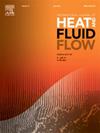使用直接数值模拟法计算太阳能加热下的湍流分层明渠流(Pr=7 以下
IF 2.6
3区 工程技术
Q2 ENGINEERING, MECHANICAL
International Journal of Heat and Fluid Flow
Pub Date : 2024-11-06
DOI:10.1016/j.ijheatfluidflow.2024.109620
引用次数: 0
摘要
本文研究了以比尔-朗伯定律为模型的辐射体积热源作用下分层明渠流的湍流结构,普朗特数(Pr)从 0.07 到 Pr=7。直接数值模拟(DNS)被用来模拟明渠流动。为了克服当 Pr>1 时解析热场所需的计算资源增加的问题,采用了一种使用二次插值的多分辨率方法来解析不同空间和时间分辨率的温度场和动量场。该方案在内部计算流体动力学(CFD)代码中实施。为进一步降低计算成本,使用最小通道模拟输出对 Pr=2.2 的 DNS 和 7 种流体进行了初始化。在中性(λ=0)、近中性(λ=0.1)和稳定(λ=0.5)热分层条件下,分别对 Pr=0.07、0.22、0.71、2.2 和 7 进行了模拟。结果表明,Pr 对分层流的流动结构和湍流特性有很大影响,尤其是在自由表面附近。与较低的 Pr 值相比,Pr=7 的流速、温度梯度和浮力效应更高。对于 Pr=7 的分层流,对雷诺应力和湍流热通量的研究表明,表面附近的湍流有明显的阻尼,流动表现为近似层流。本文章由计算机程序翻译,如有差异,请以英文原文为准。
Turbulent stratified open channel flow with solar heating up to Pr=7 using Direct Numerical Simulation
This paper investigates the turbulent structure of stratified open-channel flow subjected to a radiative volumetric heat source modelled by the Beer–Lambert law, for Prandtl numbers () varying from 0.07 to . Direct Numerical Simulation (DNS) was employed to model the open-channel flow. To overcome the increased computational resources required to resolve the thermal fields when , a multi-resolution method using quadratic interpolation was employed to resolve the temperature and momentum fields on different spatial and temporal resolutions. This scheme was implemented in an in-house computational fluid dynamics (CFD) code. To further reduce the computation cost, the DNS of and 7 fluids were initialised using the outputs of minimal channel simulations. The simulations were conducted for , 0.22, 0.71, 2.2, and 7 under neutral (), near-neutral (), and stable () thermal stratification. The results demonstrate that significantly affects the flow structure and turbulence characteristics of stratified flows, particularly near the free surface. This includes higher velocity, temperature gradient, and buoyancy effects for compared to lower values. For stratified flow, examination of the Reynolds stresses and turbulent heat flux reveals significant damping of turbulence near the surface, with flow displaying near-laminar behaviour.
求助全文
通过发布文献求助,成功后即可免费获取论文全文。
去求助
来源期刊

International Journal of Heat and Fluid Flow
工程技术-工程:机械
CiteScore
5.00
自引率
7.70%
发文量
131
审稿时长
33 days
期刊介绍:
The International Journal of Heat and Fluid Flow welcomes high-quality original contributions on experimental, computational, and physical aspects of convective heat transfer and fluid dynamics relevant to engineering or the environment, including multiphase and microscale flows.
Papers reporting the application of these disciplines to design and development, with emphasis on new technological fields, are also welcomed. Some of these new fields include microscale electronic and mechanical systems; medical and biological systems; and thermal and flow control in both the internal and external environment.
 求助内容:
求助内容: 应助结果提醒方式:
应助结果提醒方式:


